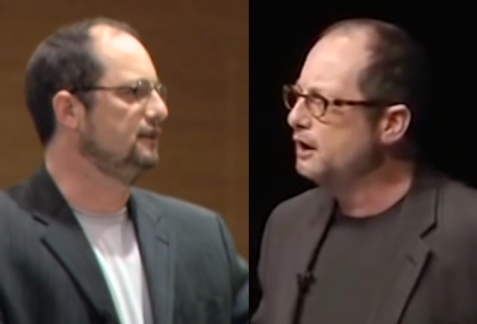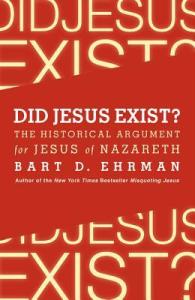
In Misquoting Jesus, Bart Ehrman deals among other things with “complications in knowing the ‘original text’” of the New Testament. He takes Paul’s letter to the Galatians as one example. He then presents a number of problems in knowing what Paul actually meant to say. First, “Galatia was not a single town with a single church; it was a region in Asia Minor (modern Turkey) in which Paul had established churches. When he writes to the Galatians, is he writing to one of the churches or to all of them?” Ehrman suggests that Paul wrote the letter for all of the churches. Ehrman continues:
“Suppose he made multiple copies. How did he do it? To begin with, it appears that this letter, like others by Paul, was not written by his hand but was dictated to a secretarial scribe. Evidence for this comes at the end of the letter, where Paul added a postscript in his own handwriting, so that the recipients would know that it was he who was responsible for the letter (a common technique for dictated letters in antiquity): ‘See with what large letters I am writing you with my own hand’ (Gal. 6:11). His handwriting, in other words, was larger and probably less professional in appearance than that of the scribe to whom he had dictated the letter.
“Now, if Paul dictated the letter, did he dictate it word for word? Or did he spell out the basic points and allow the scribe to fill in the rest? Both methods were commonly used by letter writers in antiquity. If the scribe filled in the rest, can we be assured that he filled it in exactly as Paul wanted? If not, do we actually have Paul’s words, or are they the words of some unknown scribe? But let’s suppose that Paul dictated the letter word for word. Is it possible that in some places the scribe wrote down the wrong words? Stranger things have happened. If so, then the autograph of the letter (i.e., the original) would already have a ‘mistake’ in it, so that all subsequent copies would not be of Paul’s words (in the places where his scribe got them wrong).
“Suppose, though, that the scribe got all the words 100 percent correct. If multiple copies of the letter went out, can we be sure that all the copies were also 100 percent correct? It is possible, at least, that even if they were all copied in Paul’s presence, a word or two here or there got changed in one or the other of the copies. If so, what if only one of the copies served as the copy from which all subsequent copies were made—then in the first century, into the second century and the third century, and so on? In that case, the oldest copy that provided the basis for all subsequent copies of the letter was not exactly what Paul wrote, or wanted to write.
“Once the copy is in circulation—that is, once it arrives at its destination in one of the towns of Galatia—it, of course, gets copied, and mistakes get made. Sometimes scribes might intentionally change the text; sometimes accidents happen. These mistake-ridden copies get copied; and the mistake-ridden copies of the copies get copied; and so on, down the line. Somewhere in the midst of all this, the original copy (or each of the original copies) ends up getting lost, or worn out, or destroyed. At some point, it is no longer possible to compare a copy with the original to make sure it is ‘correct,’ even if someone has the bright idea of doing so.
“What survives today, then, is not the original copy of the letter, nor one of the first copies that Paul himself had made, nor any of the copies that were produced in any of the towns of Galatia to which the letter was sent, nor any of the copies of those copies. The first reasonably complete copy we have of Galatians (this manuscript is fragmentary; i.e., it has a number of missing parts) is a papyrus called P 46 (since it was the forty-sixth New Testament papyrus to be catalogued), which dates to about 200 C.E. That’s approximately 150 years after Paul wrote the letter. It had been in circulation, being copied sometimes correctly and sometimes incorrectly, for fifteen decades before any copy was made that has survived down to the present day. We cannot reconstruct the copy from which P 46 was made. Was it an accurate copy? If so, how accurate? It surely had mistakes of some kind, as did the copy from which it was copied, and the copy from which that copy was copied, and so on.
“In short, it is a very complicated business talking about the ”original” text of Galatians. We don’t have it. The best we can do is get back to an early stage of its transmission, and simply hope that what we reconstruct about the copies made at that stage—based on the copies that happen to survive (in increasing numbers as we move into the Middle Ages)—reasonably reflects what Paul himself actually wrote, or at least what he intended to write when he dictated the letter.” (Bart D. Ehrman, Misquoting Jesus, pp. 58–60; my emphases added)
Let us apply this same reasoning to what Ehrman says in Did Jesus Exist about the famous passage of 1 Thessalonians 2:14–16. Ehrman argues that the passage was indeed written by Paul and the real reason for suspecting this is that the passage is not missing in any single manuscript:
“For one thing, what is the hard evidence that the words were not in the letter of 1 Thessalonians as Paul wrote it? There is none. We do not of course have the original of l Thessalonians; we have only later copies made by scribes. But in not a single one of these manuscripts is the line (let alone the paragraph) missing. Every surviving manuscript includes it. If the passage was added sometime after the fall of Jerusalem, say, near the end of the first Christian century or even in the second, when Christians started blaming the fall of Jerusalem on the fact that the Jews had killed Jesus, why is it that none of the manuscripts of l Thessalonians that were copied before the insertion was made left any trace on the manuscript record? Why were the older copies not copied at all? I think there needs to be better evidence of a scribal insertion before we are certain that it happened. And recall, we are not talking about the entire paragraph but only the last line.” (Bart D. Ehrman, Did Jesus Exist, pp. 123–124; my emphases added)
First we must assume that the same principle laid out for Paul’s letter to the Galatians also is true for his first letter to the Thessalonians. In Misquoting Jesus, Ehrman asks the obvious question; “what if only one of the copies served as the copy from which all subsequent copies were made—then in the first century, into the second century and the third century, and so on?” And what if someone added something to that copy which in turn was copied? As Ehrman says, “[s]ometimes scribes might intentionally change the text” and “[t]hese mistake-ridden copies get copied; and the mistake-ridden copies of the copies get copied; and so on, down the line.” In fact “[s]omewhere in the midst of all this, the original copy (or each of the original copies) ends up getting lost, or worn out, or destroyed.”
Here Ehrman seemingly proposes that it could be that “only one of the copies served as the copy from which all subsequent copies were made” and that the text of this copy might have been intentionally changed by the scribe so that we end up with a copy where the wording is changed and we “cannot reconstruct the copy from which” our preserved copy was made. We do not know if it was accurate. In fact Ehrman says in Misquoting Jesus that the “first reasonably complete copy we have of Galatians” is P 46 from c. 200 CE, although this manuscript is fragmentary. And this fragmentary manuscript does not include 1 Thessalonians 2:14–16.
So why would there then be such a big problem that “in not a single one of these manuscripts is the line (let alone the paragraph [of 1 Thessalonians 2:14–16]) missing”? Ehrman obviously thinks that it is possible that only one of the copies served as the copy from which all subsequent copies were made and that this continued from the first century into the third century, and so on. He also thinks that both unintentional and deliberate changes were made and at least the unintentional were made every time a manuscript was copied, while the original copies eventually gets destroyed. He also concludes that the “first reasonably complete copy we have of Galatians” is from c. 200 and one of the gaps of that manuscript covers 1 Thessalonians 2:3–5:5, so we do not even know if 1 Thessalonians 2:14–16 was part of that manuscript.
So why might only one copy of Paul’s letter to the Galatians has served as the copy from which all subsequent copies were made, but not just one copy of Paul’s letter to the Thessalonians? Did Ehrman mean that the alterations had to be made only to the first copy and if it was made say some 30 to 50 years later, there would be such an enormous amount of copies that some would survive and attest to different readings? He asks why the older copies were not copied. But if so, what is then the point of saying that scribes altered the text intentionally and this in several steps and that we “cannot reconstruct the copy from which P 46 was made. It surely had mistakes of some kind, as did the copy from which it was copied, and the copy from which that copy was copied, and so on”? Why could not we simply compare it to all the correct readings which must have been preserved in all the other manuscripts copied from “the older copies”, as Ehrman in Did Jesus Exist? suggests they would have been?
Roger Viklund, May 12, 2012
 In Did Jesus Exist Bart D. Ehrman, much to my surprise, defends the authenticity of this passage. (Above, for the sake of convenience, I am using the translation Ehrman provides in his book.) I have searched his other books to see whether he changed his mind or actually held this position earlier. In God’s Problem: How the Bible Fails to Answer Our Most Important Question–Why We Suffer from 2008, he discusses this passage on p. 148ff without giving a hint [as far as I can tell through the preview at Amazon] that it might not be genuine. So obviously he has for some time believed that this passage was indeed written by Paul.
In Did Jesus Exist Bart D. Ehrman, much to my surprise, defends the authenticity of this passage. (Above, for the sake of convenience, I am using the translation Ehrman provides in his book.) I have searched his other books to see whether he changed his mind or actually held this position earlier. In God’s Problem: How the Bible Fails to Answer Our Most Important Question–Why We Suffer from 2008, he discusses this passage on p. 148ff without giving a hint [as far as I can tell through the preview at Amazon] that it might not be genuine. So obviously he has for some time believed that this passage was indeed written by Paul.